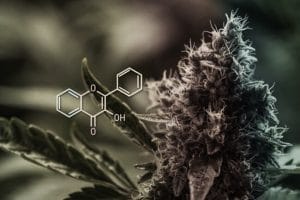 Each cannabis strain has its unique taste and aroma. The effects are also widely varied: calming, uplifting/energetic, pain-relieving, creatively stimulating and mixtures of the aforementioned.
Each cannabis strain has its unique taste and aroma. The effects are also widely varied: calming, uplifting/energetic, pain-relieving, creatively stimulating and mixtures of the aforementioned.
The reason for this lies in the composition of cannabinoids, but what few people know is that the content of the lesser-known molecules, called terpenes, terpenoids and flavanoids, also plays a crucial role in the effect.
Generally, there is a huge focus on THC/CBD and Indica/Sativa respectively when assessing the effects of cannabis.
No wonder, because it makes it easy to categorise and gives some fixed metrics to judge against.
Furthermore, it is convenient for e.g. doctors and scientists to dose according to fixed standards. The same applies to pharmaceutical companies that can make profitable products by isolating and testing these specific elements, without having to deal with all the immensely complicated biochemical synergies.
The truth is that we don’t know much about how and why cannabis has its effects – and even less about how the different ingredients interact naturally.
Cannabis is a complex plant with over 220 active chemical compounds. Of these, cannabinoids make up 85, terpenes 120 and flavanoids 20.
What are flavanoids?
Flavanoids are far from exclusive to cannabis, and researchers have identified over 6000 variants in nature, in everything from flowers and fruits to vegetables.
The word “flavanoid” comes from the Latin “flavus”, which refers to the colour yellow in nature. This makes sense, as the main function of flavanoids is the pigmentation of plants. Flowers and brightly coloured vegetables in particular get their beautiful colours from flavanoids, with the aim of attracting bees and other pollinators.
However, certain flavanoids have so far only been found in the cannabis plant. These are known as cannaflavins.
Cannaflavins – and flavanoids in general – are perhaps the most under-researched aspect of the cannabis plant.
Like terpenes (more on them later), flavanoids have a crucial role in how we perceive smells and tastes, but their effects go far beyond this.
Pharmacologically active components of flavanoids
Preliminary research results indicate that the flavanoids of the cannabis plant are pharmacologically highly active and possess a number of medically beneficial effects.
For example, Cannaflavin A has been shown to have strong anti-inflammatory properties by acting inhibitory on the inflammatory molecule, PGE-2, and that the effect is up to 20 times stronger than Aspirin .
Cannaflavin B and C are currently being researched to uncover potential medical effects. Other active flavanoids found in cannabis are Orientin, Quercetin, Silymarin and Kaempferol which all have anti-inflammatory, antioxidant, antifungal properties and possibly also potential in treating cancer.
What are terpenes and terpenoids?
Terpenes and terpenoids are abundant in humans, animals and plants.
Terpenes are volatile molecules that easily burst and evaporate, and along with flavanoids are responsible for the cannabis plant’s smell and taste. Between 10-30% of cannabis aromatic molecules derive from the terpenes, and the majority of the scent one associates with cannabis such as citrus, musk, berry, mint and pine is the result of the terpenes (and flavanoids).
Essential oils from the cannabis plant consist mainly of terpenes. In aromatherapy, many have long used terpenes, for example, the terpenes in lavender oil provide a calming and relaxing effect, while the terpenes in rosemary increase concentration and a sense of general well-being.
Ift. plants, the primary role of terpenes is chemical defense. Some terpenes deter predators and parasites, others reduce the metabolism of attacking insects, so they grow and reproduce more slowly. Others act as poisons, killing them on contact, while other terpenes attract beneficial predators that eat the plant’s enemies.
The difference between terpenes and terpenoids
.. is that terpenes are simple carbon hybrids (a kind of building block), while terpenoids have been denatured by oxidation (drying and curing of the top shoots) and consist of different functional groups. In practice, the two terms are often conflated to simply “terpenes”.
What are the effects and how do they develop?
The terpenes are secreted by the same glands on the plant as the cannabinonides, i.e. in the form of crystals/resins. There are many factors affecting the development of terpenes such as climate, weather, plant age, soil type, the type of fertiliser used and even the time of day.
Very surprisingly, research has shown that terpenes are psychoactive and have an effect on the effects of cannabis, but exactly why and how remains to be seen.
So far, over 100 terpenes have been identified in the cannabis plant, and “
The Entourage Effect
“are also present here, interacting in synergy with the cannabionides and flavanoids.
Individually, each terpene is associated with specific properties and beneficial effects, such as anesthetic, anti-inflammatory, anti-anxiety and many more. However, each terpene can proportionally alter its property and effect in the presence of cannabis’ other active substances in a phenomenon dubbed “
The Entourage Effect
“.
The difference between terpenes can be extremely subtle and understated, but they can make a marked difference to. the end product for growers as well as provide additional depth to the cannabis experience. In addition, therapeutically there are many good reasons to be aware of how terpenes, with their possible medicinal effects, can be beneficial in interaction with various cannabinoids and flavanoids.









